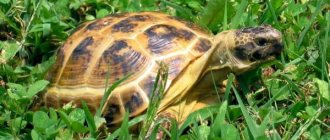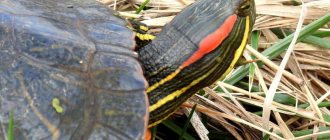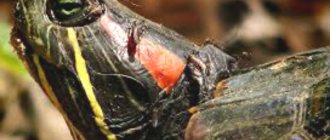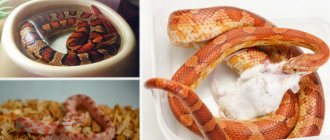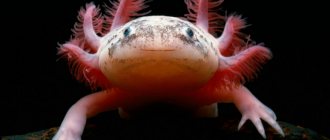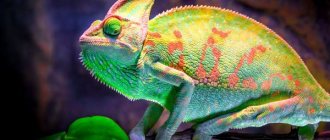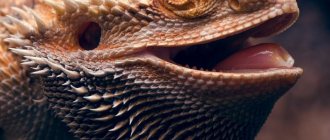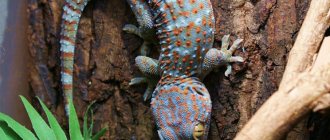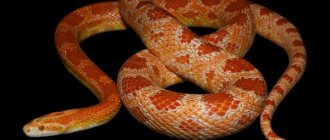Under normal conditions, with proper care, red-eared sliders can live up to 30 years. It often happens that due to improper care, owners shorten the life of their pets to 2-3 years. It is a mistake to think that to keep a reptile you need to fill a basin with water and put a few stones in it.
Since turtles are quite demanding, you need to prepare excellent conditions for keeping them with all the necessary accessories.
Buying a Yellow-bellied Turtle
When buying a reptile at a pet store or market, it is recommended to take it to a veterinarian for examination. This is necessary to determine the general condition, whether there are diseases, and to look for the presence of injuries.
If you already have sea turtles at home, and you purchased another one, then the new one must be kept separately for 90 days. It is also impossible to keep adults and small ones in the same place, this can lead to injury to the latter. Only turtles of approximately the same size are kept together.
After changing its place of residence, the turtle behaves inhibited or, conversely, actively. During this period, you must not disturb her, but do not forget to feed her.
Feeding
A turtle's diet is based on the needs of a particular species. The majority is food of animal origin, supplemented by permitted vegetables. You can feed turtles with special dry food, but only high-quality food and no more than once a week.
Fish and seafood
What is the best way to feed a turtle? The basis of nutrition for waterfowl turtles of any kind is low-fat small fish. Live is preferred, but not required.
The following types are suitable:
- cod;
- hake;
- perch;
- crucian carp
Fish caviar (raw!) is a real delicacy for turtles; it can and should also be offered to your pets.
It is not recommended to feed turtles with fatty fish, such as:
- capelin;
- sprat;
- sprat
The diet will also be enriched with raw seafood:
- squid;
- crabs;
- crayfish;
- shrimps;
- mussels;
- scallops;
- octopuses.
Plant food
You can give it no more than twice a week, preferably less often.
Suitable:
- dandelion leaf, plantain leaf;
- lettuce and cabbage;
- seaweed (dry);
- apples, bananas, pears;
- carrots, cucumbers, pumpkin.
Meat
Once a week you are allowed to treat your turtle to lean poultry or lean beef. It is more beneficial to give chicken or beef liver in small quantities.
Insects
The following insects are suitable in dry or fresh (even live) form:
- zoophobus;
- mealworm;
- cricket;
- locusts;
- snails;
- bloodworm;
- gammarus;
- earthworms;
- cockroaches (ash, periplanets);
- wax moth larvae;
It is not advisable to feed a turtle this food more than once a week, and it is allowed to feed moth larvae no more than once a month.
Where to feed, how often
It is recommended to organize feeding in the same place in the aquarium. The amount of food given to the animal at one time should be eaten by it within 20 minutes. As soon as the reptile begins to get distracted and scatter pieces of food, it means it has had enough and no longer needs it. It is recommended to remember this volume.
Babies are fed daily, often twice a day, dividing the daily amount of food into morning feeding and evening feeding, and adults are fed in one meal every two or three days.
Prohibited Products
It is strictly forbidden to feed your turtle food that has undergone heat treatment, especially fried food.
The following should not be included in the diet:
- spinach;
- peas;
- radish;
- cauliflower;
- mushrooms;
- pineapples;
- citrus fruit;
- nuts;
- porridge;
- dairy and fermented milk products;
- bakery products;
- crab sticks.
It is also prohibited to give seeds and seeds of permitted fruits and vegetables.
How to handle it correctly
When a person wants to pick up a turtle, it is recommended to remember that it is wet and slippery. She doesn’t like these manipulations, so she hisses, can scratch, since she has large claws, and is even capable of biting. Therefore, the pet must be held with both hands at the same time.
After spending time with the reptile, you need to wash your hands with hygiene products, since it is a waterfowl and has its own microflora. It is necessary to ensure that the food and water in the container are fresh. Turtles spread salmonella. Therefore, it is forbidden to wash the reptile in the kitchen sink and its accessories too.
The amazing world of sea turtles
Scientists are still searching for an answer to the question of the origin of turtles. From the myth it is known that the globe was supported by a giant turtle, the ancestor of which remains unknown. A 220-million-year-long mystery remains unsolved—that’s how long turtles have inhabited planet Earth.
- Sea turtles have excellent memory and, after long journeys, can return to the place where they were born. This is due to their ability to navigate the Earth's magnetic field.
- 100 million years - this is exactly how much time has passed since the emergence of leatherback sea turtles, which are recognized as the oldest.
- Leatherback turtles are capable of living in waters more than a kilometer deep.
- Green turtles and turtles can weigh up to half a ton.
- In order to find a suitable place to lay eggs, turtles can swim 20 thousand kilometers.
- A female sea turtle can lay 1,000 eggs in one breeding season.
- Residents of a place near the Melaya River still believe that the turtle Manoi was the creator of the world.
- The leatherback turtle has the highest body temperature, which allows it to live in northern latitudes. However, to do this, she needs to constantly receive adequate nutrition, otherwise she will not tolerate such living conditions.
- When in danger, the turtle makes a sound reminiscent of the hissing of a Levantine viper.
- Sea turtles reach full maturity by age 30. Before this, they are considered cubs, incapable of reproduction.
- The smallest sea turtles do not exceed 75 centimeters in length.
- The largest leatherback turtle found on land weighed 960 kg. The length of the turtle turned out to be just as impressive – almost 3 meters. The discovery was made recently, and the male turtle cannot claim to be the largest. The real giant Archelon weighed about two tons, and the length and width of its shell were 4 meters.
- Leatherback turtles are recognized as the fastest, capable of moving at speeds of up to 35 km/h. This is almost 2.5 times the speed of the first car, invented in the mid-18th century. By the way, their running speed on land is also quite high - 10-15 km/hour. However, large turtles are not able to reach speeds of more than a kilometer per hour.
Caring for a turtle
Sea turtles require water and land. Therefore, the first thing to do is purchase an aquarium with a volume of at least 150 liters. If the reptile is small, then it grows relatively quickly. Because of this, it is recommended to buy a container “for growth”. Water is poured so that there is enough for the pet to swim and turn over.
An island of sushi is placed in the aquarium; it is sold in a specialized store. The pet will periodically crawl out and bask under the installed lamp. The temperature on land exceeds water temperature by 10 degrees. The island should occupy a quarter of the aquarium in area. But exceeding the temperature regime on the island is unacceptable. This will lead to overheating, which means maintenance will not be performed properly.
Requirements for the island:
- one side of the land should be immersed in water, that is, half-flooded;
- position the land so that the reptile does not get stuck between the glass of the aquarium and the side of the land;
- made of safe materials;
- stayed well on the water so that the pet could not turn it over;
- textured surface.
Content Benefits
Waterfowl turtles are kept at home primarily due to their simplicity and ease of care.
It is customary to highlight the following advantages of the content:
- Unpretentiousness. To live together in a city apartment, it is enough to equip the turtle with an aquaterrarium that is optimal in terms of water temperature and lighting, and do not forget to feed it on time and correctly.
- Inexpensive food. An adult turtle is fed 2 - 4 times a week.
- Calm and peaceful character. The animal does not make loud sounds and does not require attention.
- Longevity. A rare pet can boast an average life expectancy of 30 - 40 years. In addition, turtles are very persistent and hardy animals, are little susceptible to diseases and infections, and perfectly adapt to climatic conditions.
- Safety. The reptile will not bite or scratch, and you can trust a child to care for it, but in this case, you need to explain the basic rules of maintenance and care, and also control that a curious child does not accidentally harm the turtle.
How to heat an island
Turtles love to bask on the sand under the sun's rays. This should be done at home, only instead of the sun there will be a lamp. The reptile feels good when the temperature of the shell under the lamp is 30–35 degrees. To monitor this parameter, you must place a thermometer. If the thermometer readings exceed the norm, the pet may get burns. We must not forget that if there is more than one turtle in the aquarium, they love to climb on top of each other. This makes it dangerous to get close to a heat lamp.
When diving, your pet splashes drops in different directions. They can get on a working lamp, as a result, it will burst. This means that the lamp is positioned in such a way as to exclude all these moments.
Chinese Trionix
One of the few representatives of soft-bodied turtles. The shell does not have hard horny plates on the surface, and consists only of thick but soft skin.
The characteristic features of the structure include the following:
- The leathery shell is completely covered with small tubercles, by which experts can track the age of the reptile.
- The traditional color is represented by green-brown colors and a yellow border along the lower edge of the shell.
- In addition to all external features, the turtle is distinguished by its relatively small size. The weight of an adult rarely exceeds 4 kg.
- Very sharp horny ridges that completely replace teeth in reptiles.
- The structural features of the shell provided the Chinese turtle with a unique opportunity - full skin respiration. A sufficiently developed blood network under the skin allows the animal to stay under water for up to 15 hours.
- Very fast reaction to signs of danger and to the appearance of food in the visibility zone.
Thanks to their soft shell, reptiles easily burrow into the ground. This property should be remembered when organizing an aquarium with this variety of turtles.
Water requirements
The red-eared turtle is a waterfowl reptile. She feeds, defecates, and sleeps in water. Therefore, water should always be clean and fresh. Dirty food causes discomfort to the pet and is a source of disease.
The lowest water level in a container is measured by the size of its shell. She should calmly roll over onto her stomach if she ends up on her back. But the declared level is the lowest. Ideally, more water is recommended, then it stays clean longer.
When changing water, it must be left for 24 hours. It is important to ensure that the water does not drop to 20 degrees, but is between 22–28 degrees. If it is necessary to heat the water, install a heater. The water temperature is controlled using a thermometer.
Since the pet performs all its physiological needs in the aquarium, the water becomes dirty and smells unpleasant. To avoid this, change the water once every 7 days. To perform this procedure less frequently, you need to install a filter. The internal filter does not cope with water after the turtle, it is weak. Of course, you can buy an external filter, it fits perfectly, but its price is not cheap.
Appearance
A turtle at home is exotic, and its appearance is also unusual.
Animal body:
- head and eyes;
- neck;
- beak and tongue;
- shell;
- color;
- limbs;
- tail;
- dimensions.
The head of these reptiles is streamlined and designed in such a way that the animal can quickly pull it under its shell. In some species, the length of the neck is equal to the length of the shell.
These animals have a strong and hard beak with bulges inside, with sharp or jagged edges that act as teeth.
The function of the shell is protection. The dorsal (upper) part is called the carapace, the ventral (lower) part is called the plastron.
The size of a turtle is measured by the length of its shell. Determine the length using a ruler despite the fact that the surface of the dorsal part is uneven.
They grow slowly throughout life. In adult individuals, the length of the carapace is 20–30 cm.
The tail is hidden inside the shell. The tip of the tail in some species is pointed, similar to a spike.
Differences between Central Asian and red-eared cats in appearance
Appearance Central Asian Red-eared
| Color | Yellow-beige color, shapeless dark spots on the shell. | The carapace has characteristic stripes of olive, black, and yellow colors. |
| Plastron | Dark color. | Smooth, variegated color: dark spots on a yellow background. |
| Head | The upper jaw is hooked. | From the eyes to the neck, on both sides there are yellow-red lines resembling ears. |
| Eyes | Located on the sides of the head in such a way that they look down; small, black. | Directed forward and upward, located near the crown. |
| Limbs | The front paws are flat, designed to dig soil, and the hind paws are powerful and strong. They have four toes on their front paws with blunt claws. | The feet have leathery membranes for swimming. |
| Dimensions | Cubs are born 3–3.4 cm long and weigh 10–12 grams. By the second year of life, the size will increase to 5 cm, by the fourth to 9 cm. The weight of an adult turtle grows to 2 kg. | A newborn cub is 2.4 cm long, and during the first year of life it gains 2.5–4.5 cm. At two years, its size will be 8 cm, at six years - 18 cm. |
Sense organs
Turtles have good low-frequency hearing and excellent color vision.
Red-eared turtles have an excellent sense of smell and smell. They see both in water and above water. Hearing is like that of cats: they can distinguish dull sounds and vibrations. Nerve endings pass through the shell. Animals with a sense of touch distinguish the taste of food.
Aquatic turtles are not adapted to breathe underwater; they swim up for oxygen.
Lifespan
The average lifespan of these animals in their natural environment is 20–30 years. If kept at home, if the rules of care are followed, pets will live up to 40-50 years.
In captivity, these reptiles grow faster as they receive high-quality nutrition and a comfortable life.
When determining age, they are guided by size and also count the number of rings on the shell. In one year, 2–3 rings are formed. But this growth is not uniform; it is influenced by conditions of detention, illness, and hibernation.
In older individuals, the carapace is smooth, the growth rings are pale. The younger the turtle, the brighter its color.
Inappropriate maintenance and disease are the main causes of death.
In another article, we took a closer look at how long turtles live.
How to feed your pet
The sea turtle's diet is varied:
- artificial food;
- fish;
- fish food;
- vegetables;
- insects;
- plants for the aquarium.
But with all the variety, it is necessary to control so that the reptile does not overeat. For this purpose, it is recommended to use a calcium diet from time to time. The pet loves to hunt for its prey, but does not refuse carrion. The main thing is to remember to add calcium to your menu. The turtle does not produce saliva while eating, so it pulls the food into the water. You can use this for your own benefit, that is, feed your pet in another container with water, then the water in the aquarium will remain clean longer.
It is important to know that the older the turtle, the more plant foods it eats and the less protein. Therefore, the diet of an adult or old turtle consists of 25% protein and 75% plant foods.
Diseases
Despite the endurance and resilience of red-eared turtles, sometimes due to errors in keeping the reptiles get sick and die. Knowledge about common turtle ailments and treatment methods will help you avoid such consequences:
- Pneumonia - the disease develops due to being kept in cold water or lack of food. Symptoms include hoarse breathing, lethargy, weakness and pallor of the mucous membranes. Treatment is carried out using an injection of Baytril 2.5% - 0.4 ml/kg into the brachial muscle.
- Bone ailments - if white spots on the shell and detachments are detected in a red-eared turtle, we can conclude that there is a fungal infection. Pets are treated with Clotrimazole ointment, treating damaged areas.
- Lack of calcium - with this problem, reptiles' shell peels off. The deficiency can be eliminated by giving pets small fish with bones and calcium supplements.
By following the maintenance rules, red-eared turtles will not be affected by any diseases.
